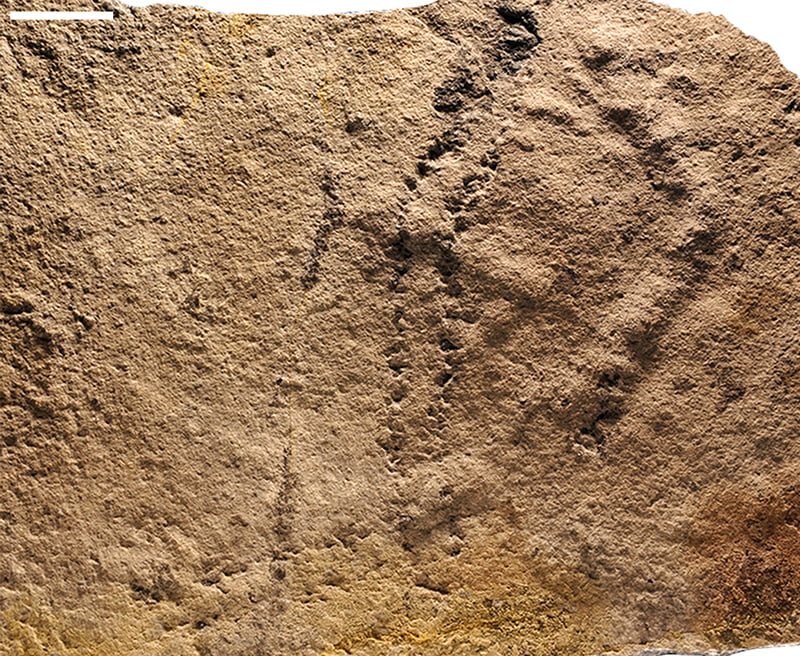
A close up photograph of the world’s oldest known footprints, made by a small unknown bug, were found in South China by Virginia Tech’s Shuhai Xiao and a research team. The total area covered by the tracks is no larger than the palm of an average person’s hand.
A team of scientists, led by Shuhai Xiao, of the Virginia Tech College of Science, have discovered the oldest known footprints ever found, estimated at 540 million to 550 million years old.
Found in a small chunk of sediment rock in a shallow sea bottom in China, the tiny tracks – millimeters in width – were made by an unknown bug-like creature no bigger than a thumb. The footrail is only a few inches long, no bigger than an average hand palm. The findings of these ancient footprints are published in the latest issue of Science Advances and may help scientists determine when and how legs and limbs evolved.
“We were trying to answer the question ‘when did animals began to have appendages, such as legs and leg like structures?’,” said Xiao, a professor in the Department of Geosciences. “The formation of legs helped animals to change the world. Animals use legs and limbs to move sediments, to help mate, to feed, to fight, and, of course, to travel.”
Xiao and his colleagues from the Nanjing Institute of Geology and Paleontology and Center for Excellence in Life and Paleoenvironment, both part of the Chinese Academy of Sciences, discovered the trackway fossils from rocks in the Yangtze Gorges area of South China.
Previously identified footprints pegged the first walking animals with paired appendages at between 540 million and 530 million years old, in the early Cambrian Period. The new fossils are up to 10 million years older than previously known footprints.
“Many animals, from bumble bees to bristle worms, have legs or leglike appendages,” Xiao said. “Some have a few appendages, others, such as centipedes and millipedes, have hundreds, but all have an even number of appendages placed symmetrically on both sides of the body. Appendages come in different forms, some are jointed legs as in bumble bees, and others are simple outgrowths of the body.”
The when of the tracks is known, but not the who.
“We only found the footprints,” Xiao said. “We have not yet found the animals that made the footprints. Unlike many modern animals that have hard skeletons, these early animals did not yet evolve hard skeletons, so their likelihood of being preserved is slim.”
Xiao and his team gauge the little crawler may have had legs similar to a bumble bee or a bristle worm, as evidenced by the width and gait of the tracks. The trackways – so tiny they can be missed if seen at the wrong angle or in low light – are about half an inch in width and a few inches in length, consisting of two rows of dimples on the surface of the rocks.
Future visits to the site by Xiao and his team will include searches for more evidence of early animals.
The rock with the foot imprints was formed from sediments deposited in a shallow sea bottom that was covered by microbial mats similar to pond scums. Animals moved across on the microbial mats and sediments using their appendages, leaving tracks of footprints that were later preserved to create the fossils at the heart of this study.
“Oddly, the tracks sometimes transition into tunnels, suggesting that the animals occasionally dug into the microbial mat,” added Xiao, also an affiliated member of the Global Change Center at Virginia Tech.
Scientists believe that the animals may have dug into the microbial mats to mine oxygen or food. The microbial mats, constructed by a group of photosynthetic bacteria known as cyanobacteria that produced oxygen as a side product, were a reliable source of both oxygen and food for early animals.
“Back then, oxygen was scarce in the atmosphere and ocean, and animals needed to find oxygen to make a living,” Xiao said. “Pond scums were an animal’s best friend.”
Funding for the study was supported by National Natural Science Foundation of China, the Chinese Academy of Sciences, the U.S. National Science Foundation, and the National Geographic Society.


